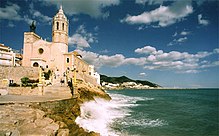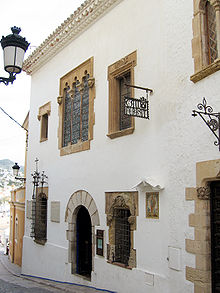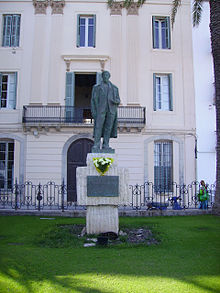Sitges
| Sitges municipality | ||
|---|---|---|

|
||
| coat of arms | Map of Spain | |

|
|
|
| Basic data | ||
| Autonomous Community : | Catalonia | |
| Province : | Barcelona | |
| Comarca : | Garraf | |
| Coordinates | 41 ° 14 ′ N , 1 ° 49 ′ E | |
| Height : | 10 msnm | |
| Area : | 43.85 km² | |
| Residents : | 29,307 (Jan 1, 2019) | |
| Population density : | 668.35 inhabitants / km² | |
| Postal code : | 08870 | |
| Municipality number ( INE ): | 08270 | |
| administration | ||
| Official language : | Castilian , Catalan | |
| Mayor : | Miquel Forns i Fusté | |
| Website : | www.sitges.cat | |
| Location of the municipality | ||

|
||
Sitges [ ˈsidʒəs ] ( Province of Barcelona ) is located between the towns of Castelldefels and Vilanova i la Geltrú in the Comarca Garraf 36 km southwest of Barcelona .
location
Geographical location
Sitges is a popular seaside resort on the Costa del Garraf and borders the chalky mountains of the Garraf (natural park) to the north and east .
Neighboring communities
The neighboring communities are Vilanova i la Geltrú in the west, Sant Pere de Ribes , Olivella in the north and Castelldefels in the east .
Local division
The urban area consists of four districts:
- Sitges
- Garraf
- Les Botigues de Sitges
- Vallcarca
traffic
Good transport links to the west ( Tarragona ) and east (Barcelona) are provided by both a toll motorway ( C-32 ) and a railway line. Sitges is part of the S-Bahn network ( Cercanías line C2-Sud) from Barcelona. The airport of Barcelona (Prat) is 35 km away by bus, train and car .
climate
The mountains of the Garraf form a natural protection against the cold winds from the north, which creates a mild Mediterranean climate . The sun shines more than 300 days a year, the average temperature is 18 ° C.
history
The name Sitges comes from the pre-Romanesque period and comes from Sitja , which means "granary".
The first people lived in Sitges as early as the Stone Age .
The oldest excavations from the Iberian era are dated to the 4th to 3rd centuries BC. Dated.
Already in the 1st century there were two town centers on the territory of Sitges. In Roman times, the port of Sitges was used as a transshipment point for products from the Penedès (region around Vilafranca ).
In the 11th century, there was a castle that belonged to Barcelona on the site of today's town hall. The de Sitges family ruled from 1116 to 1814 . In 1814 Sitges became free and joined the crown. Thereafter, Sitges went through various wars as well as periods of famine and epidemics . During this time the people lived mainly from agriculture , fishing and the goods that were handled in the port.
In the 19th century, Sitges benefited from the royal decree that Catalonia could trade directly with America . 27% of Catalans who traded with America were from Sitges. The trade was mainly in clothing, wine and brandy . In the second half of the 19th century, many former residents who had made it rich in America (called "Los americanos") returned to Sitges. Here they built magnificent villas that can still be seen today. With the capital they brought with them, they built spinning and shoe factories. From this a large shoe industry developed in the 20th century, in which 80% of the adult population was active. Today there is only one shoe factory left.
Tourism developed from the end of the 19th century . With the construction of a railway line Sitges – Barcelona (1888) and the appearance of the first medical and therapeutic baths (1887), more and more holiday guests from Barcelona came to the seaside resort of Sitges. After the arrival of the artist Santiago Rusiñol (1891), Sitges developed its reputation as a place of culture and modernism . By the 1930s, Sitges became a center of European tourism.
In 2010 the Bilderberg Conference took place in Sitges.
beaches
The 17 beaches with fine sand and good water quality are an attraction for tourists from all over Europe. A little outside the village, on the cliffs of the Garraf, small bays invite you to swim. The flat, wide beaches monitored by lifeguards are right there. Six of the 17 beaches are ISO 14001 certified.
Cityscape
A palm-fringed, wide, three-kilometer-long promenade stretches from the rocky cliff in the east along the whole place to the golf course in the west. There are numerous shops, bars and pubs in the narrow streets of the old town center.
The district adjacent to the beach is largely free of modern blocks and high-rise buildings. There are numerous gems of architecture, Art Nouveau and other art epochs. There are magnificent villas from the 20th century along the beach promenade. The towering structure is the church of St. Bartholomew and St. Thekla, built on a rock on the beach.
population
| year | 1991 | 1996 | 2001 | 2004 | 2007 |
|---|---|---|---|---|---|
| Residents | 13,109 | 16.801 | 19,893 | 23,172 | 26,225 |
Culture
Numerous cultural events have made Sitges famous. The big international Tango-Argentino-Festival in July, a film festival for fantasy films , a classic car rally and a chess tournament take place every year. The carnival , the flower carpets laid out for Corpus Christi , the fireworks and the Fiesta Major are also attractions .
The city festival in honor of the patron saint Santa Thekla is celebrated in the week of September 23rd.
Museums / artist associations:
- Museum landscape of Sitges
- Museu del Cau Ferrat - The former home and studio of Santiago Rusiñol houses u. a. Works by Rusiñol, Ramon Casas , El Greco , Zuloaga and Picasso .
- Museu Romàntic Can llopis - Real estate and way of life from the 18th and 19th centuries
- Museu de Maricel - works of Romantic , Renaissance , Baroque , Catalan culture, maritime culture
- Fundació Stämpfli - contemporary art
- Casa Bacardí in the old market hall of Sitges (guided tours on the company's history and the production process of Bacardí rum)
- Various art galleries
- Luministic School of Sitges
carnival
Sitges has been celebrating Carnival in February / March for over a century. The festivities begin on Weiberfastnacht with the arrival of King Carnestoltes. Folk dances and xatonades (traditional salad served with omelette) are characteristic elements of the carnival. The two most significant moments are the “Rua de la Disbauxa” (Parade of the dissolute) on Sunday evening and the “Rua de l'Extermini” (Parade of the destruction) on Tuesday evening. Around 40 boats with more than 2000 visitors fill Sitges.
gastronomy
Xato is the most typical dish in Sitges. The main ingredients are endive salad, cod, tuna, anchovies, eggplant and black olives. The basis of the dish is its sauce, which is prepared with chili, almonds, garlic, olive oil, salt, vinegar and hot pepper. The entire dish consists of various omelets and “coca de llardons”, a typical Catalan cake made from bacon cracklings, for dessert.
The cuisine also consists of many Catalan seafaring dishes, such as squid with potatoes and garlic sauce, peppers stuffed with cod, and other dishes with tuna and other seafood. Malvasia is a liqueur that in Sitges is preferably served with dessert.
leisure
Sitges offers numerous opportunities for leisure activities such as hiking or cycling in the nature park, horse riding and the water sports sailing , surfing and swimming .
Sports facilities in Sitges:
- 18-hole golf course
- Aiguadolç marina with 742 berths
- Garraf Marina with 527 berths
- Port Ginesta marina with 1442 berths. The largest marina in Catalonia is on the border with Castelldefels .
- Club Nautic sailing school
- Indoor swimming pool
Town twinning
- Bagnères-de-Luchon in the Haute-Garonne department ( France ), since 1981
- Andorra (Teruel) in Aragon , Spain , since 1991
Personalities
- Facundo Bacardí (1814–1886), founder of the Bacardi company
- Joaquim Sunyer (1874–1956), painter
- Antonio Mingote (1919–2012), draftsman and author
- José de Udaeta (1919–2009), dancer and choreographer
- Carmen Cervera (* 1943), art collector
- Florencia Coll (* 1959), painter
Web links
Individual evidence
- ↑ Cifras oficiales de población resultantes de la revisión del Padrón municipal a 1 de enero . Population statistics from the Instituto Nacional de Estadística (population update).






